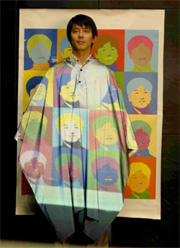Home > Highlighting JAPAN > Highlighting Japan JANUARY 2012 > Here's Looking Through You!
Highlighting JAPAN
COVER STORY: Tomorrow's World
Caption: Professor Masahiko Inami (left) looks through the optical camouflage device at the laboratory of Keio University Graduate School of Media Design. The device renders the model (right) "invisible."
Credit: YOSHIFUSA HASHIZUME
Here's Looking Through You!
Professor Masahiko Inami of Keio University has invented an "invisibility cloak," inspired by Japanese animation. The Japan Journal's Osamu Sawaji reports.

The model appears invisible as the image of the poster behind him is projected on his cloak, which is made from retroreflective materials.
Credit: YOSHIFUSA HASHIZUME
"When I was in my doctoral course, the research associate in the lab gave me a book and said 'If you want to have a discussion with me, read this.' The book was Ghost in the Shell," Professor Inami says. "In this manga there's a technology called optical camouflage that enables people to blend into their surroundings and disappear. At that time I was researching the creation of three-dimensional images by using a projector. I came up with an idea that, though it may not be possible to make objects physically invisible, it may be possible from an engineering aspect to make them visually invisible by blending them into the surrounding scenery through three-dimensional images."
The optical camouflage invented by Professor Inami is an illusion. To make people invisible, you can make them blend into the scenery by projecting background scenery hidden behind them on their body. In other words, the scenery behind a person is shot in real time and then three-dimensionally projected onto the body with a projector, just like a movie is played on the screen.
However, in the same way that a movie becomes distorted and does not show up well when it is projected onto an uneven curtain, a person cannot be invisible when the background scenes are merely projected onto the body. And even if the projected portions are made even, images cannot be seen when the surrounding areas are bright.
Retroreflective materials offer a solution for these challenges since they characteristically reflect the light in the same path as it enters. These materials are used for road signs and bicycle reflectors, and they can be seen clearly when light hits them in the day and at night. When using a cloak made of the materials, the projected light (color) does not reflect diffusely, and returns directly to the viewer. This makes it possible to project the background three-dimensional images clearly on the uneven cloak, irrespective of the brightness in the surrounding areas.
Professor Inami's presentation of his optical camouflage technology at the 1999 SIGGRAPH (Special Interest Group on Computer Graphics) exhibition in the United States, attracted a great deal of attention. "At SIGGRAPH, I showed optical camouflage as sideshow entertainment for the main research results, but a long line formed for the sideshow," he says, laughing. "One of my favorite comics when I was an elementary school student was Doraemon. I still read this series by Fujiko F. Fujio to get ideas for research. In an intellectual sense, Japanese pop culture became my flesh and blood."
Optical camouflage is foreseen as being applied in diverse fields such as medicine. Surgery can sometimes become difficult when the afflicted area is hard to see due to the surgeon's hands and the surgical instruments. Optical camouflage will enable these to disappear from the surgeon's view. Development of medical technology using optical camouflage is in fact underway at a university in the United States.
Professor Inami also conducted a joint experiment with an automaker in using retroreflective materials for the interior. Using optical camouflage to view surrounding areas from the driver's seat without anything blocking the field of vision will help to dramatically and significantly reduce the risk of accidents.
"The driver will feel like he's driving a glass car," Professor Inami says. "Sir Arthur C. Clarke said 'Any sufficiently advanced technology is indistinguishable from magic.' I want to develop technology like magic that general people can use easily in the future."
© 2009 Cabinet Office, Government of Japan






